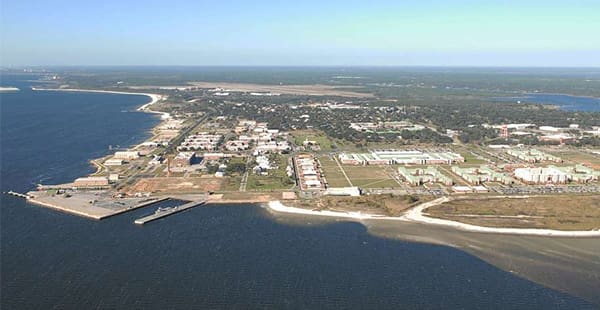Naval Air Station Pensacola History
Naval Air Station Pensacola (NAS Pensacola) began as Pensacola Navy Yard in 1826. President John Quincy Adams and the Navy chose to establish the station on Pensacola Bay. It was used for shipbuilding and as the home port for military activity in the Gulf of Mexico and the Caribbean.
Confederate soldiers burned down much of the yard during the Civil War. After rebuilding, many of the yard’s structures were destroyed again in 1906 by a hurricane and a tidal wave. The government closed Pensacola Navy Yard in 1911, citing maintenance costs and availability of other navy yards.
At the same time, the Navy was adapting to the new field of aviation. In 1913, the Navy’s Chambers Board recommended that the old Pensacola Navy Yard become the first aeronautic station. NAS Pensacola opened in 1914 with 32 service members and 7 aircraft. When the United States entered World War I (WWI) in 1917, it had grown to house 38 pilots, 163 service members and 54 aircraft. About a year and a half later, it had expanded to 6,000 service members on a mile of beachfront facilities. The base had trained 1,000 pilots for the war.
After WWI, NAS Pensacola continued to train about 100 pilots a year. It gained a reputation for being the “Annapolis of the Air.” Heading into World War II (WWII), the base increased training to 1,100 cadets a month. During the Korean War and the Vietnam War, it trained thousands of pilots.
Besides training, the base also adapted as aviation technology became more advanced. It raised its training requirements to meet the changing needs of newer aircraft. Hurricane Ivan damaged or destroyed almost 800 buildings in 2004, prompting a massive rebuilding. Today, NAS Pensacola trains nearly 60,000 students annually.
Naval Air Station Pensacola History at a Glance
- Other Names: Pensacola Navy Yard
- Location: Pensacola, Florida
- Owner: U.S. Navy
- Years of Operation: 1826 – Present
- Wartime Operations: Civil War, WWI, WWII, Korean War, Vietnam War
- Size of Shipyards: 5,804 acres
- Types of Ships Built/Serviced: Ash lighters, derrick barges, dredges, open lighters, pile drivers, sloops, steamers, water barges
The Navy used asbestos in various ways for many decades. It insulated pipes, boilers, wires and much more. It was incorporated into textiles, paints, tiles and cement. Aircraft used many of these asbestos products, as did ships and facilities themselves.
Resources for Mesothelioma Patients
Asbestos at Naval Air Station Pensacola
For decades, the Navy used asbestos in ships, planes and facilities. Asbestos is a mineral that is naturally strong, flexible and heat resistant. As such, the Navy used it in many applications, including:
- Asbestos blankets
- Asbestos compounds
- Asbestos tape
- Boiler batts and blocks
- Cement products
- Fireproofing insulation
- Flooring tiles and sheets
- Paints and coatings
- Paper products
- Pipe coverings
- Roofing felts
- Textile products
- Thermal insulation
- Wall coverings
Veterans and workers who were employed at NAS Pensacola may have been at risk of asbestos exposure.
Asbestos Exposure at Naval Air Station Pensacola
Many occupations at NAS Pensacola were at risk of asbestos exposure. Workers who had to install, repair or remove asbestos insulation were at increased risk. But even those who worked around it, like Navy veterans, were at risk, too.
Occupations that had a risk of asbestos exposure at NAS Pensacola include:
- Boiler workers
- Carpenters
- Electricians
- Engineers
- Insulators
- Joiners
- Machinists
- Masons
- Mechanics
- Molders
- Painters
- Pipefitters
- Sheet metal fabricators
- Shipfitters
- Steamfitters
- Toolmakers
- Track workers
- Trimmers
- Veterans
- Welders
- Wharf builders
- Woodworkers
Many Naval base workers exposed to asbestos have since developed related diseases like mesothelioma.
Asbestos Lawsuits and Settlements for Naval Air Station Pensacola
Asbestos victims may seek compensation through several avenues. First, they can file lawsuits against responsible companies. A successful mesothelioma lawsuit compensates asbestos victims for medical bills, lost wages and more. Some lawsuits end in settlements like these:
- A Navy worker stationed at NAS Pensacola in the 1950s won over $1 million.
- Another Navy worker stationed at NAS Pensacola from 1961 to 1982 won over $1 million.
You can explore the legal options with a mesothelioma lawyer. They can help ensure you pursue the best compensation route for your case. Besides lawsuits, they can also help with Veterans Affairs claims and asbestos trust fund claims.
Asbestos Trusts Associated With Naval Air Station Pensacola
NAS Pensacola does not have an asbestos trust fund. But workers may be eligible to make claims against companies that supplied NAS Pensacola with asbestos products.
Asbestos Trust Funds and Eligible Years of Employment
The following companies provided asbestos products to NAS Pensacola. After exposing innocent people to asbestos and facing many asbestos lawsuits, these companies filed for bankruptcy and created trust funds to pay victims. If an individual worked at NAS Pensacola and developed a disease such as mesothelioma, they may be able to file a claim against these trusts.
| Asbestos Company Name | Eligibility Start Date | Eligibility End Date |
|---|---|---|
| ACandS | 4/3/1944 | |
| Armstrong WI Trust | 1/1/1969 | 12/31/1982 |
| Eagle-Picher Industries | ||
| North American Refractories | 1/1/1963 | 3/31/1976 |
| Owens-Corning | 12/31/1982 | |
| Shook & Fletcher | ||
| Turner & Newall | 1/1/1941 | 12/31/1982 |









